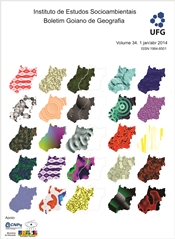RISK OF DENGUE IN MUNICIPALITIES PANTANAL OF MATO GROSSO, BRAZIL - DOI 10.5216/bgg.v34i1.29317
DOI:
https://doi.org/10.5216/bgg.v34i1.29317Abstract
The aim of this study is to analyze the risk of transmission, via time/spatial model, of the confirmed cases of dengue in the municipalities belonging to the Pantanal of Mato Grosso. We considered the cases of dengue confirmed and the original inhabitant recorded in the period from 2009 to 2011 at the Information System for
Notifiable Diseases (SINAN) in the epidemiological Vigilance – Cuiabá and the Cáceres Regional Health. Three measures of risk time/spatial were used: frequency, duration and intensity, managed in the software ArcGIS 9.2, ESRI. Moran´s Global and Local index were used to evaluate the spatial autocorrelation of the three index. In
the period studied, the cities of Cáceres, Poconé, Santo Antônio de Leverger and Nossa Senhora do Livramento presented the highest rates of frequency, duration and intensity, however, Cáceres showed the highest risk of the disease. Moran´s Global Index showed low correlation and Moran´s Local Index showed clusters in some
cities according to the index used. These indexes may be useful in the authorities decision and public health.
Key words: geo, geohealth, epidemiology, Pantanal Biome.
Downloads
Downloads
Published
How to Cite
Issue
Section
License
Authors will not receive any payment for publishing their work in Boletim Goiano de Geografia. Therefore, they must grant all rights to the journal. However, they are entirely and exclusively responsible for the published contents, and editors are free to make corrections or adjustments to texts in conformity with publication guidelines.







